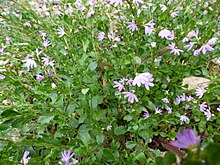
Hibiscus heterophyllus, commonly known as native rosella or toilet paper bush, is a flowering plant in the family Malvaceae. It a shrub or small tree with white, pale pink or yellow flowers with a dark red centre and grows in New South Wales and Queensland.

Scaevola aemula, commonly known as the fairy fan-flower or common fan-flower, is a species of flowering plant in the family Goodeniaceae. It has mostly egg-shaped leaves and blue, mauve or white fan-shaped flowers. It grows in New South Wales, South Australia and Victoria.

Scaevola hookeri, commonly known as the creeping fan-flower or alpine fan-flower, is a species of flowering plant in the family Goodeniaceae. It has white or blue flowers with a yellow throat and grows in eastern Australia.
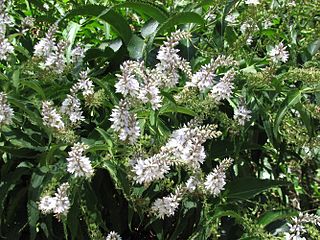
Veronica derwentiana, commonly known as Derwent speedwell, is a flowering plant species of the family Plantaginaceae, endemic to south-eastern Australia. It is a perennial with toothed leaves and white or pale blue flowers in terminal sprays in spring and summer.
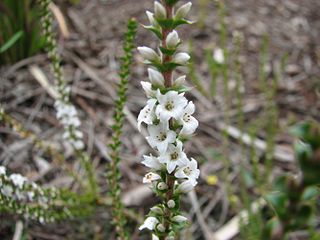
Epacris gunnii is a species of flowering plant in the family Ericaceae and is endemic to south-eastern Australia. It is an erect shrub with hairy branchlets, concave, sharply-pointed, broadly egg-shaped leaves, and tube-shaped, white flowers arranged along the stems.

Scaevola ramosissima, commonly known as the purple fan-flower or snake flower is a flowering plant in the family Goodeniaceae and is endemic to south eastern Australia. It has wiry, horizontal branches and purple fan-shaped flowers.

Comesperma volubile, commonly known as love creeper, is a slender climber in the family Polygalaceae. It is a twining plant with linear leaves and pea-like blue flowers.

Scaevola calendulacea commonly known as dune fan-flower, is a flowering plant in the family Goodeniaceae. It is a small, mat-forming shrub with blue fan-shaped flowers with a yellow centre and grows on sand dunes in eastern and southern Australia.
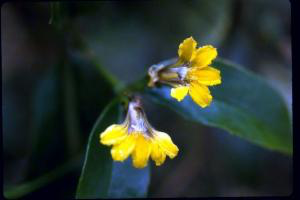
Scaevola enantophylla, commonly known as climbing fan-flower,is a species of flowering plant in the family Goodeniaceae and is endemic to Queensland. It is a scrambling vine with yellow fan-shaped flowers, and the only species in the genus with leaves arranged opposite.

Brachyscome decipiens, commonly known as field daisy, is a perennial herb in the family Asteraceae and is endemic to Australia. It is a small herb with white or pale blue flowers.

Pimelea curviflora, also known as curved rice-flower, is a shrub in the family Thymelaeaceae and is endemic to Australia. It is a small, hairy shrub with greenish-yellow or red tubular flowers.
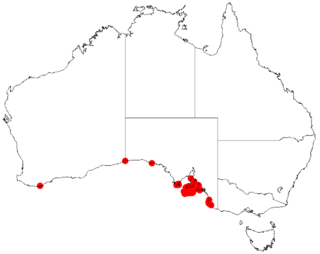
Scaevola angustata is a species of flowering plant belonging to the family Goodeniaceae. It has pale blue to purple flowers and is endemic to South Australia.

Scaevola depauperata, commonly known as skeleton fan-flower, is a species of flowering plant in the family Goodeniaceae. It is a small understorey shrub with blue, mauve or cream-white flowers. It grows in mainland states of Australia with the exception of Western Australia.

Scaevola virgata is a species of flowering plant in the family Goodeniaceae. It is a perennial, much-branched, small shrub has white to blue flowers and endemic to Western Australia.

Scaevola parvibarbata is a species of flowering plant in the family Goodeniaceae. It is an upright herb with fan-shaped mauve or greenish flowers and grows in New South Wales, Queensland, South Australia and the Northern Territory.
Scaevola glutinosa is a species of flowering plant in the family Goodeniaceae. It is a small, spreading shrub with fan-shaped blue flowers, toothed, oval-shaped leaves and grows in Queensland.

Scaevola glabrata is a species of flowering plant in the family Goodeniaceae. It is a small, spreading shrub with fan-shaped blue flowers and elliptic to egg-shaped leaves.
Scaevola densifolia is a species of flowering plant in the family Goodeniaceae. It is a small, spreading shrub with fan-shaped cream or white flowers and is endemic to Western Australia.

Scaevola anchusifolia commonly known as silky scaevola, is a species of flowering plant in the family Goodeniaceae. It is a small, upright or decumbent shrub with fan-shaped blue to bluish white flowers and is endemic to Western Australia.

Scaevola thesioides is a species of flowering plant in the family Goodeniaceae and is endemic to the southwest of Western Australia. It is a spreading subshrub to perennial herb with thread-like to lance-shaped leaves and hairy, fan-shaped, pale blue to white flowers.
